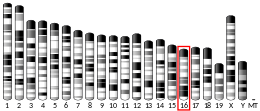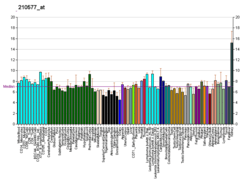Calcium-sensing receptor
The calcium-sensing receptor (CaSR) is a Class C G-protein coupled receptor which senses extracellular levels of calcium ions. It is primarily expressed in the parathyroid gland and the renal tubules of the kidney. In the parathyroid gland, it controls calcium homeostasis by regulating the release of parathyroid hormone (PTH).[5] In the kidney it has an inhibitory effect on the reabsorption of calcium, potassium, sodium, and water depending on which segment of the tubule is being activated.[6]
Signal transduction
The release of PTH is inhibited in response to elevations in plasma calcium concentrations and activation of the calcium receptor. Increased calcium binding on the extracellular side gives a conformational change in the receptor, which, on the intracellular side, initiates the phospholipase C pathway,[7][8] presumably through a Gqα type of G protein, which ultimately increases intracellular concentration of calcium, which inhibits vesicle fusion and exocytosis of parathyroid hormone. It also inhibits (not stimulates, as some[9] sources state) the cAMP dependent pathway.[8]
Pathology
Mutations that inactivate a CaSR gene cause familial hypocalciuric hypercalcemia (FHH) (also known as familial benign hypercalcemia because it is generally asymptomatic and does not require treatment),[10] when present in heterozygotes. Patients who are homozygous for CaSR inactivating mutations have more severe hypercalcemia.[11] Other mutations that activate CaSR are the cause of autosomal dominant hypocalcemia[12] or Type 5 Bartter syndrome. An alternatively spliced transcript variant encoding 1088 aa has been found for this gene, but its full-length nature has not been defined.[13]
Therapeutic application
The drugs cinacalcet and etelcalcetide are allosteric modifiers of the calcium-sensing receptor.[14] They are classified as a calcimimetics, binding to the calcium-sensing receptor and decreasing parathyroid hormone release.
Calcilytic drugs, which block CaSR, produce increased bone density in animal studies and have been researched for the treatment of osteoporosis. Unfortunately clinical trial results in humans have proved disappointing, with sustained changes in bone density not observed despite the drug being well tolerated.[15][16] More recent research has shown the CaSR receptor to be involved in numerous other conditions including Alzheimer's disease, asthma and some forms of cancer,[17][18][19][19][20] and calcilytic drugs are being researched as potential treatments for these. Recently it has been shown that biomimetic bone like apatite inhibits formation of bone through endochondral ossification pathway via hyperstimulation of extracellular calcium sensing receptor.[21]
Interactions
Calcium-sensing receptor has been shown to interact with filamin.[22][23]
References
- GRCh38: Ensembl release 89: ENSG00000036828 - Ensembl, May 2017
- GRCm38: Ensembl release 89: ENSMUSG00000051980 - Ensembl, May 2017
- "Human PubMed Reference:". National Center for Biotechnology Information, U.S. National Library of Medicine.
- "Mouse PubMed Reference:". National Center for Biotechnology Information, U.S. National Library of Medicine.
- D'Souza-Li L (Aug 2006). "The calcium-sensing receptor and related diseases". Arquivos Brasileiros de Endocrinologia e Metabologia. 50 (4): 628–39. doi:10.1590/S0004-27302006000400008. PMID 17117288.
- Vezzoli, Giuseppe; Soldati, Laura; Gambaro, Giovanni (2009-04-01). "Roles of calcium-sensing receptor (CaSR) in renal mineral ion transport". Current Pharmaceutical Biotechnology. 10 (3): 302–310. doi:10.2174/138920109787847475. ISSN 1873-4316. PMID 19355940.
- InterPro: IPR000068 GPCR, family 3, extracellular calcium-sensing receptor-related Retrieved on June 2, 2009
- Coburn JW, Elangovan L, Goodman WG, Frazaõ JM (Dec 1999). "Calcium-sensing receptor and calcimimetic agents". Kidney International Supplements. 73: S52–8. doi:10.1046/j.1523-1755.1999.07303.x. PMID 10633465.
- Costanzo, Linda S. (2007). BRS Physiology (Board Review Series). pp. 260. ISBN 978-0-7817-7311-9.
- Pidasheva S, Canaff L, Simonds WF, Marx SJ, Hendy GN (Jun 2005). "Impaired cotranslational processing of the calcium-sensing receptor due to signal peptide missense mutations in familial hypocalciuric hypercalcemia". Human Molecular Genetics. 14 (12): 1679–90. doi:10.1093/hmg/ddi176. PMID 15879434.
- Egbuna OI, Brown EM (Mar 2008). "Hypercalcaemic and hypocalcaemic conditions due to calcium-sensing receptor mutations". Best Practice & Research. Clinical Rheumatology. 22 (1): 129–148. doi:10.1016/j.berh.2007.11.006. PMC 2364635. PMID 18328986.
- Mancilla EE, De Luca F, Baron J (Jul 1998). "Activating mutations of the Ca2+-sensing receptor". Molecular Genetics and Metabolism. 64 (3): 198–204. doi:10.1006/mgme.1998.2716. PMID 9719629.
- "Entrez Gene: CaSR calcium-sensing receptor (hypocalciuric hypercalcemia 1, severe neonatal hyperparathyroidism)".
- Torres PU (Jul 2006). "Cinacalcet HCl: a novel treatment for secondary hyperparathyroidism caused by chronic kidney disease". Journal of Renal Nutrition. 16 (3): 253–8. doi:10.1053/j.jrn.2006.04.010. PMID 16825031.
- Nemeth EF, Shoback D (Jun 2013). "Calcimimetic and calcilytic drugs for treating bone and mineral-related disorders". Best Practice & Research. Clinical Endocrinology & Metabolism. 27 (3): 373–84. doi:10.1016/j.beem.2013.02.008. PMID 23856266.
- John MR, Harfst E, Loeffler J, Belleli R, Mason J, Bruin GJ, Seuwen K, Klickstein LB, Mindeholm L, Widler L, Kneissel M (Jul 2014). "AXT914 a novel, orally-active parathyroid hormone-releasing drug in two early studies of healthy volunteers and postmenopausal women". Bone. 64: 204–10. doi:10.1016/j.bone.2014.04.015. PMID 24769332.
- Kim JY, Ho H, Kim N, Liu J, Tu CL, Yenari MA, Chang W (Nov 2014). "Calcium-sensing receptor (CaSR) as a novel target for ischemic neuroprotection". Annals of Clinical and Translational Neurology. 1 (11): 851–66. doi:10.1002/acn3.118. PMC 4265057. PMID 25540800.
- Aggarwal A, Prinz-Wohlgenannt M, Tennakoon S, Höbaus J, Boudot C, Mentaverri R, Brown EM, Baumgartner-Parzer S, Kállay E (Feb 2015). "The calcium-sensing receptor: A promising target for prevention of colorectal cancer". Biochimica et Biophysica Acta (BBA) - Molecular Cell Research. 1853 (9): 2158–67. doi:10.1016/j.bbamcr.2015.02.011. PMC 4549785. PMID 25701758.
- Dal Prà I, Chiarini A, Armato U (Feb 2015). "Antagonizing amyloid-β/calcium-sensing receptor signaling in human astrocytes and neurons: a key to halt Alzheimer's disease progression?". Neural Regeneration Research. 10 (2): 213–8. doi:10.4103/1673-5374.152373. PMC 4392667. PMID 25883618.
- Yarova PL, Stewart AL, Sathish V, Britt RD, Thompson MA, P Lowe AP, Freeman M, Aravamudan B, Kita H, Brennan SC, Schepelmann M, Davies T, Yung S, Cholisoh Z, Kidd EJ, Ford WR, Broadley KJ, Rietdorf K, Chang W, Bin Khayat ME, Ward DT, Corrigan CJ, T Ward JP, Kemp PJ, Pabelick CM, Prakash YS, Riccardi D (Apr 2015). "Calcium-sensing receptor antagonists abrogate airway hyperresponsiveness and inflammation in allergic asthma". Science Translational Medicine. 7 (284): 284ra60. doi:10.1126/scitranslmed.aaa0282. PMC 4725057. PMID 25904744.
- Sarem, Melika; Heizmann, Miriam; Barbero, Andrea; Martin, Ivan; Shastri, V. Prasad (2018-07-03). "Hyperstimulation of CaSR in human MSCs by biomimetic apatite inhibits endochondral ossification via temporal down-regulation of PTH1R". Proceedings of the National Academy of Sciences. 115 (27): E6135–E6144. doi:10.1073/pnas.1805159115. ISSN 0027-8424. PMC 6142224. PMID 29915064.
- Hjälm G, MacLeod RJ, Kifor O, Chattopadhyay N, Brown EM (Sep 2001). "Filamin-A binds to the carboxyl-terminal tail of the calcium-sensing receptor, an interaction that participates in CaR-mediated activation of mitogen-activated protein kinase". The Journal of Biological Chemistry. 276 (37): 34880–7. doi:10.1074/jbc.M100784200. PMID 11390380.
- Awata H, Huang C, Handlogten ME, Miller RT (Sep 2001). "Interaction of the calcium-sensing receptor and filamin, a potential scaffolding protein". The Journal of Biological Chemistry. 276 (37): 34871–9. doi:10.1074/jbc.M100775200. PMID 11390379.
Further reading
- Hendy GN, D'Souza-Li L, Yang B, Canaff L, Cole DE (Oct 2000). "Mutations of the calcium-sensing receptor (CASR) in familial hypocalciuric hypercalcemia, neonatal severe hyperparathyroidism, and autosomal dominant hypocalcemia". Human Mutation. 16 (4): 281–96. doi:10.1002/1098-1004(200010)16:4<281::AID-HUMU1>3.0.CO;2-A. PMID 11013439.
- Fukumoto S (Mar 2002). "[Calcium-sensing receptor in bone cells]". Nihon Rinsho. Japanese Journal of Clinical Medicine. 60 Suppl 3: 57–63. PMID 11979955.
- Tfelt-Hansen J, Schwarz P, Brown EM, Chattopadhyay N (May 2003). "The calcium-sensing receptor in human disease". Frontiers in Bioscience. 8 (6): s377–90. doi:10.2741/1068. PMID 12700051.
- Hu J, Spiegel AM (Aug 2003). "Naturally occurring mutations of the extracellular Ca2+-sensing receptor: implications for its structure and function". Trends in Endocrinology and Metabolism. 14 (6): 282–8. doi:10.1016/S1043-2760(03)00104-8. PMID 12890593.
- Aida K, Koishi S, Inoue M, Nakazato M, Tawata M, Onaya T (Sep 1995). "Familial hypocalciuric hypercalcemia associated with mutation in the human Ca(2+)-sensing receptor gene". The Journal of Clinical Endocrinology and Metabolism. 80 (9): 2594–8. doi:10.1210/jc.80.9.2594. PMID 7673400.
- Aida K, Koishi S, Tawata M, Onaya T (Sep 1995). "Molecular cloning of a putative Ca(2+)-sensing receptor cDNA from human kidney". Biochemical and Biophysical Research Communications. 214 (2): 524–9. doi:10.1006/bbrc.1995.2318. PMID 7677761.
- Chou YH, Pollak MR, Brandi ML, Toss G, Arnqvist H, Atkinson AB, Papapoulos SE, Marx S, Brown EM, Seidman JG (May 1995). "Mutations in the human Ca(2+)-sensing-receptor gene that cause familial hypocalciuric hypercalcemia". American Journal of Human Genetics. 56 (5): 1075–9. PMC 1801464. PMID 7726161.
- Garrett JE, Capuano IV, Hammerland LG, Hung BC, Brown EM, Hebert SC, Nemeth EF, Fuller F (May 1995). "Molecular cloning and functional expression of human parathyroid calcium receptor cDNAs". The Journal of Biological Chemistry. 270 (21): 12919–25. doi:10.1074/jbc.270.21.12919. PMID 7759551.
- Pollak MR, Brown EM, Estep HL, McLaine PN, Kifor O, Park J, Hebert SC, Seidman CE, Seidman JG (Nov 1994). "Autosomal dominant hypocalcaemia caused by a Ca(2+)-sensing receptor gene mutation". Nature Genetics. 8 (3): 303–7. doi:10.1038/ng1194-303. PMID 7874174.
- Pollak MR, Brown EM, Chou YH, Hebert SC, Marx SJ, Steinmann B, Levi T, Seidman CE, Seidman JG (Dec 1993). "Mutations in the human Ca(2+)-sensing receptor gene cause familial hypocalciuric hypercalcemia and neonatal severe hyperparathyroidism". Cell. 75 (7): 1297–303. doi:10.1016/0092-8674(93)90617-Y. PMID 7916660.
- Janicic N, Soliman E, Pausova Z, Seldin MF, Rivière M, Szpirer J, Szpirer C, Hendy GN (Nov 1995). "Mapping of the calcium-sensing receptor gene (CASR) to human chromosome 3q13.3-21 by fluorescence in situ hybridization, and localization to rat chromosome 11 and mouse chromosome 16". Mammalian Genome. 6 (11): 798–801. doi:10.1007/BF00539007. PMID 8597637.
- Bikle DD, Ratnam A, Mauro T, Harris J, Pillai S (Feb 1996). "Changes in calcium responsiveness and handling during keratinocyte differentiation. Potential role of the calcium receptor". The Journal of Clinical Investigation. 97 (4): 1085–93. doi:10.1172/JCI118501. PMC 507156. PMID 8613532.
- Pearce SH, Trump D, Wooding C, Besser GM, Chew SL, Grant DB, Heath DA, Hughes IA, Paterson CR, Whyte MP (Dec 1995). "Calcium-sensing receptor mutations in familial benign hypercalcemia and neonatal hyperparathyroidism". The Journal of Clinical Investigation. 96 (6): 2683–92. doi:10.1172/JCI118335. PMC 185975. PMID 8675635.
- Bai M, Quinn S, Trivedi S, Kifor O, Pearce SH, Pollak MR, Krapcho K, Hebert SC, Brown EM (Aug 1996). "Expression and characterization of inactivating and activating mutations in the human Ca2+o-sensing receptor". The Journal of Biological Chemistry. 271 (32): 19537–45. doi:10.1074/jbc.271.32.19537. PMID 8702647.
- Baron J, Winer KK, Yanovski JA, Cunningham AW, Laue L, Zimmerman D, Cutler GB (May 1996). "Mutations in the Ca(2+)-sensing receptor gene cause autosomal dominant and sporadic hypoparathyroidism". Human Molecular Genetics. 5 (5): 601–6. doi:10.1093/hmg/5.5.601. PMID 8733126.
- Freichel M, Zink-Lorenz A, Holloschi A, Hafner M, Flockerzi V, Raue F (Sep 1996). "Expression of a calcium-sensing receptor in a human medullary thyroid carcinoma cell line and its contribution to calcitonin secretion". Endocrinology. 137 (9): 3842–8. doi:10.1210/en.137.9.3842. PMID 8756555.
- Chattopadhyay N, Ye C, Singh DP, Kifor O, Vassilev PM, Shinohara T, Chylack LT, Brown EM (Apr 1997). "Expression of extracellular calcium-sensing receptor by human lens epithelial cells". Biochemical and Biophysical Research Communications. 233 (3): 801–5. doi:10.1006/bbrc.1997.6553. PMID 9168937.
- Cole DE, Janicic N, Salisbury SR, Hendy GN (Aug 1997). "Neonatal severe hyperparathyroidism, secondary hyperparathyroidism, and familial hypocalciuric hypercalcemia: multiple different phenotypes associated with an inactivating Alu insertion mutation of the calcium-sensing receptor gene". American Journal of Medical Genetics. 71 (2): 202–10. doi:10.1002/(SICI)1096-8628(19970808)71:2<202::AID-AJMG16>3.0.CO;2-I. PMID 9217223.
- Ward BK, Stuckey BG, Gutteridge DH, Laing NG, Pullan PT, Ratajczak T (1997). "A novel mutation (L174R) in the Ca2+-sensing receptor gene associated with familial hypocalciuric hypercalcemia". Human Mutation. 10 (3): 233–5. doi:10.1002/(SICI)1098-1004(1997)10:3<233::AID-HUMU9>3.0.CO;2-J. PMID 9298824.
- Quinn SJ, Kifor O, Trivedi S, Diaz R, Vassilev P, Brown E (Jul 1998). "Sodium and ionic strength sensing by the calcium receptor". The Journal of Biological Chemistry. 273 (31): 19579–86. doi:10.1074/jbc.273.31.19579. PMID 9677383.
- Magno AL, Ward BK, Ratajczak T (Feb 2011). "The calcium-sensing receptor: a molecular perspective". Endocrine Reviews. 32 (1): 3–30. doi:10.1210/er.2009-0043. PMID 20729338.
External links
- "Calcium-Sensing Receptors". IUPHAR Database of Receptors and Ion Channels. International Union of Basic and Clinical Pharmacology.
- CASRdb - Calcium Sensing Receptor Database, McGill University
- Receptors,+Calcium-Sensing at the US National Library of Medicine Medical Subject Headings (MeSH)
- CASR+protein at the US National Library of Medicine Medical Subject Headings (MeSH)





